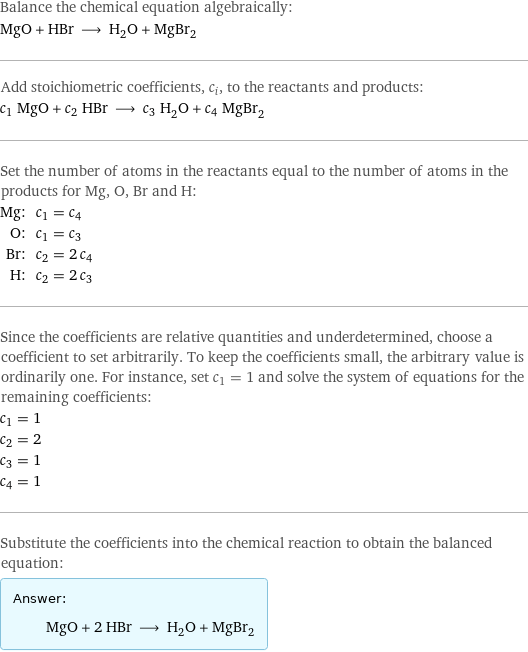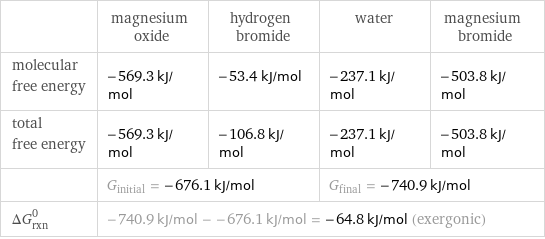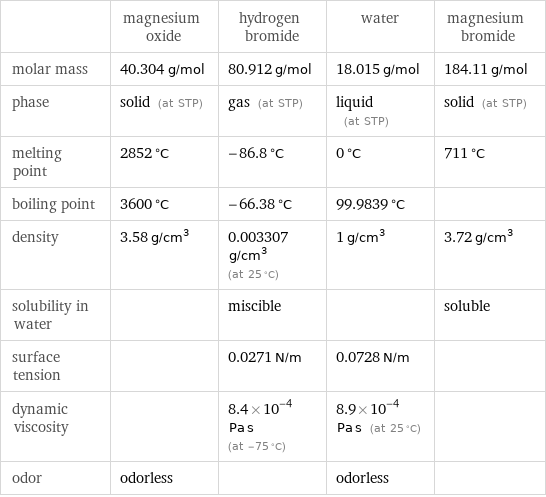Input interpretation

MgO magnesium oxide + HBr hydrogen bromide ⟶ H_2O water + MgBr_2 magnesium bromide
Balanced equation

Balance the chemical equation algebraically: MgO + HBr ⟶ H_2O + MgBr_2 Add stoichiometric coefficients, c_i, to the reactants and products: c_1 MgO + c_2 HBr ⟶ c_3 H_2O + c_4 MgBr_2 Set the number of atoms in the reactants equal to the number of atoms in the products for Mg, O, Br and H: Mg: | c_1 = c_4 O: | c_1 = c_3 Br: | c_2 = 2 c_4 H: | c_2 = 2 c_3 Since the coefficients are relative quantities and underdetermined, choose a coefficient to set arbitrarily. To keep the coefficients small, the arbitrary value is ordinarily one. For instance, set c_1 = 1 and solve the system of equations for the remaining coefficients: c_1 = 1 c_2 = 2 c_3 = 1 c_4 = 1 Substitute the coefficients into the chemical reaction to obtain the balanced equation: Answer: | | MgO + 2 HBr ⟶ H_2O + MgBr_2
Structures

+ ⟶ +
Names

magnesium oxide + hydrogen bromide ⟶ water + magnesium bromide
Reaction thermodynamics
Enthalpy

| magnesium oxide | hydrogen bromide | water | magnesium bromide molecular enthalpy | -601.6 kJ/mol | -36.3 kJ/mol | -285.8 kJ/mol | -5243 kJ/mol total enthalpy | -601.6 kJ/mol | -72.6 kJ/mol | -285.8 kJ/mol | -5243 kJ/mol | H_initial = -674.2 kJ/mol | | H_final = -5529 kJ/mol | ΔH_rxn^0 | -5529 kJ/mol - -674.2 kJ/mol = -4855 kJ/mol (exothermic) | | |
Gibbs free energy

| magnesium oxide | hydrogen bromide | water | magnesium bromide molecular free energy | -569.3 kJ/mol | -53.4 kJ/mol | -237.1 kJ/mol | -503.8 kJ/mol total free energy | -569.3 kJ/mol | -106.8 kJ/mol | -237.1 kJ/mol | -503.8 kJ/mol | G_initial = -676.1 kJ/mol | | G_final = -740.9 kJ/mol | ΔG_rxn^0 | -740.9 kJ/mol - -676.1 kJ/mol = -64.8 kJ/mol (exergonic) | | |
Equilibrium constant
![Construct the equilibrium constant, K, expression for: MgO + HBr ⟶ H_2O + MgBr_2 Plan: • Balance the chemical equation. • Determine the stoichiometric numbers. • Assemble the activity expression for each chemical species. • Use the activity expressions to build the equilibrium constant expression. Write the balanced chemical equation: MgO + 2 HBr ⟶ H_2O + MgBr_2 Assign stoichiometric numbers, ν_i, using the stoichiometric coefficients, c_i, from the balanced chemical equation in the following manner: ν_i = -c_i for reactants and ν_i = c_i for products: chemical species | c_i | ν_i MgO | 1 | -1 HBr | 2 | -2 H_2O | 1 | 1 MgBr_2 | 1 | 1 Assemble the activity expressions accounting for the state of matter and ν_i: chemical species | c_i | ν_i | activity expression MgO | 1 | -1 | ([MgO])^(-1) HBr | 2 | -2 | ([HBr])^(-2) H_2O | 1 | 1 | [H2O] MgBr_2 | 1 | 1 | [MgBr2] The equilibrium constant symbol in the concentration basis is: K_c Mulitply the activity expressions to arrive at the K_c expression: Answer: | | K_c = ([MgO])^(-1) ([HBr])^(-2) [H2O] [MgBr2] = ([H2O] [MgBr2])/([MgO] ([HBr])^2)](../image_source/e3652141a79a660d4ebdf4978cf77a4d.png)
Construct the equilibrium constant, K, expression for: MgO + HBr ⟶ H_2O + MgBr_2 Plan: • Balance the chemical equation. • Determine the stoichiometric numbers. • Assemble the activity expression for each chemical species. • Use the activity expressions to build the equilibrium constant expression. Write the balanced chemical equation: MgO + 2 HBr ⟶ H_2O + MgBr_2 Assign stoichiometric numbers, ν_i, using the stoichiometric coefficients, c_i, from the balanced chemical equation in the following manner: ν_i = -c_i for reactants and ν_i = c_i for products: chemical species | c_i | ν_i MgO | 1 | -1 HBr | 2 | -2 H_2O | 1 | 1 MgBr_2 | 1 | 1 Assemble the activity expressions accounting for the state of matter and ν_i: chemical species | c_i | ν_i | activity expression MgO | 1 | -1 | ([MgO])^(-1) HBr | 2 | -2 | ([HBr])^(-2) H_2O | 1 | 1 | [H2O] MgBr_2 | 1 | 1 | [MgBr2] The equilibrium constant symbol in the concentration basis is: K_c Mulitply the activity expressions to arrive at the K_c expression: Answer: | | K_c = ([MgO])^(-1) ([HBr])^(-2) [H2O] [MgBr2] = ([H2O] [MgBr2])/([MgO] ([HBr])^2)
Rate of reaction
![Construct the rate of reaction expression for: MgO + HBr ⟶ H_2O + MgBr_2 Plan: • Balance the chemical equation. • Determine the stoichiometric numbers. • Assemble the rate term for each chemical species. • Write the rate of reaction expression. Write the balanced chemical equation: MgO + 2 HBr ⟶ H_2O + MgBr_2 Assign stoichiometric numbers, ν_i, using the stoichiometric coefficients, c_i, from the balanced chemical equation in the following manner: ν_i = -c_i for reactants and ν_i = c_i for products: chemical species | c_i | ν_i MgO | 1 | -1 HBr | 2 | -2 H_2O | 1 | 1 MgBr_2 | 1 | 1 The rate term for each chemical species, B_i, is 1/ν_i(Δ[B_i])/(Δt) where [B_i] is the amount concentration and t is time: chemical species | c_i | ν_i | rate term MgO | 1 | -1 | -(Δ[MgO])/(Δt) HBr | 2 | -2 | -1/2 (Δ[HBr])/(Δt) H_2O | 1 | 1 | (Δ[H2O])/(Δt) MgBr_2 | 1 | 1 | (Δ[MgBr2])/(Δt) (for infinitesimal rate of change, replace Δ with d) Set the rate terms equal to each other to arrive at the rate expression: Answer: | | rate = -(Δ[MgO])/(Δt) = -1/2 (Δ[HBr])/(Δt) = (Δ[H2O])/(Δt) = (Δ[MgBr2])/(Δt) (assuming constant volume and no accumulation of intermediates or side products)](../image_source/c013f4a67892cff624cdcc5a9973388a.png)
Construct the rate of reaction expression for: MgO + HBr ⟶ H_2O + MgBr_2 Plan: • Balance the chemical equation. • Determine the stoichiometric numbers. • Assemble the rate term for each chemical species. • Write the rate of reaction expression. Write the balanced chemical equation: MgO + 2 HBr ⟶ H_2O + MgBr_2 Assign stoichiometric numbers, ν_i, using the stoichiometric coefficients, c_i, from the balanced chemical equation in the following manner: ν_i = -c_i for reactants and ν_i = c_i for products: chemical species | c_i | ν_i MgO | 1 | -1 HBr | 2 | -2 H_2O | 1 | 1 MgBr_2 | 1 | 1 The rate term for each chemical species, B_i, is 1/ν_i(Δ[B_i])/(Δt) where [B_i] is the amount concentration and t is time: chemical species | c_i | ν_i | rate term MgO | 1 | -1 | -(Δ[MgO])/(Δt) HBr | 2 | -2 | -1/2 (Δ[HBr])/(Δt) H_2O | 1 | 1 | (Δ[H2O])/(Δt) MgBr_2 | 1 | 1 | (Δ[MgBr2])/(Δt) (for infinitesimal rate of change, replace Δ with d) Set the rate terms equal to each other to arrive at the rate expression: Answer: | | rate = -(Δ[MgO])/(Δt) = -1/2 (Δ[HBr])/(Δt) = (Δ[H2O])/(Δt) = (Δ[MgBr2])/(Δt) (assuming constant volume and no accumulation of intermediates or side products)
Chemical names and formulas

| magnesium oxide | hydrogen bromide | water | magnesium bromide formula | MgO | HBr | H_2O | MgBr_2 Hill formula | MgO | BrH | H_2O | Br_2Mg name | magnesium oxide | hydrogen bromide | water | magnesium bromide IUPAC name | oxomagnesium | hydrogen bromide | water | magnesium dibromide
Substance properties

| magnesium oxide | hydrogen bromide | water | magnesium bromide molar mass | 40.304 g/mol | 80.912 g/mol | 18.015 g/mol | 184.11 g/mol phase | solid (at STP) | gas (at STP) | liquid (at STP) | solid (at STP) melting point | 2852 °C | -86.8 °C | 0 °C | 711 °C boiling point | 3600 °C | -66.38 °C | 99.9839 °C | density | 3.58 g/cm^3 | 0.003307 g/cm^3 (at 25 °C) | 1 g/cm^3 | 3.72 g/cm^3 solubility in water | | miscible | | soluble surface tension | | 0.0271 N/m | 0.0728 N/m | dynamic viscosity | | 8.4×10^-4 Pa s (at -75 °C) | 8.9×10^-4 Pa s (at 25 °C) | odor | odorless | | odorless |
Units
